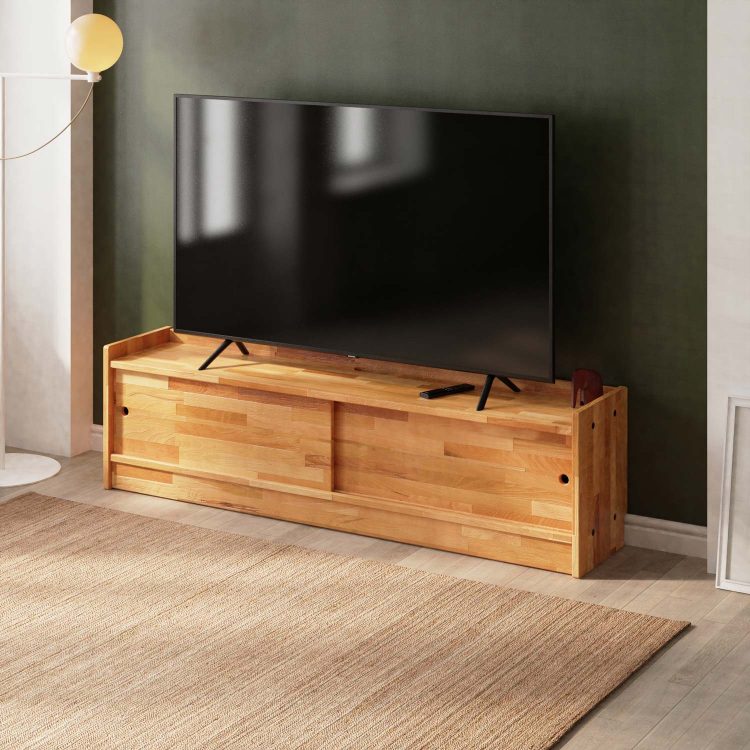SORA
REGMAR
RIFT
VALL
SHAVA
YURA
YVON
LUNT
ULFA
SHAVA
ANWEN
FIGWIT
WHAT TO CONSIDER WHEN CHOOSING A TV UNIT?
The television, as it determines the general seating arrangement in the space it occupies, can be said to make TV units one of the most prominent furniture pieces. Therefore, TV units are one of the main furniture items in the space they occupy. With various styles, materials, and sizes available, TV units are important pieces of furniture that can guide the overall decoration style of your living space in terms of both aesthetics and functionality, so making the right choice is important.
The first thing you need to do is decide on the wall where the unit will be placed and determine its dimensions based on both this and the size of the TV you plan to buy. If you’re getting a large TV, be sure to avoid a TV unit that is too small in proportion to it, as this is one of the most important factors. Depending on the design of the space, TV units can sometimes be designed as a whole with the wall and can be quite long, providing a stylish look when integrated. However, choosing a TV unit much smaller than your television, even if you have enough space, will result in an unbalanced look.
When it comes to the height of the TV unit, the dimensions generally range from 30 to 47 cm, making it difficult to talk about a standard height. The choice here depends on your usage preferences. However, you c example an use the height of the sitting part of your couch as a reference criterion. For , you can choose the height of your TV unit based on this if you have a low couch, or determine the suspension height accordingly if it is a wall-mounted type.
Another factor to consider is storage. TV units that offer ample storage space are both decorative and functional in this regard. Therefore, choosing the right TV unit not only increases the efficiency of your space but also is one of the keys to achieving an aesthetic look on the main wall of the room.
Drawers are generally preferred in TV units. Especially in units that come as a set with upper and lower modules, drawers in the lower part provide easy use. You can also increase the variety of use with closed or open compartments in the upper module and enrich these compartments with objects. You can opt for TV units with upper shelves like Anwen and Figwit in this regard. However, if you have a small space, using only the lower module without causing a cluttered look on the walls and enriching the wall with shelves if needed will provide a more spacious area. Especially secondary TV rooms such as living rooms outside the main living area are smaller, so more minimal TV units in terms of size and form will be a much more correct choice. Models from our products such as Shava, Yura, and Atlas, which do not include upper shelves and only have lower modules with closed compartments, organize the space and are quite suitable for such areas.
As with all other furniture choices, it is beneficial to consider the style of other furniture in the space when choosing a TV unit. Actually, in decoration, there is often not just one correct way. You can make numerous alternatives according to your imagination, your own style, and your usage expectations. So saying that all furniture must always be compatible with each other would not be correct. For example, the eclectic design style, which has been a trend lately, is a concept created with different styles of furniture and design approaches without adhering to a single style, and when you find the right balance, it can provide quite marginal and extraordinary spaces. However, there is a fine line between creating a complex space. Examine the space well at this point; your feelings will be the best guide for you. So in a living space where metals are heavily used, which can be mainly described as loft style, you don’t necessarily have to use a metal TV unit. Actually, we can say that the main issue is to achieve a balance of materials.
Finally, paying attention to some technical but potentially impacting details on the final appearance is also quite important. For example, the cables, which can look quite bad if not planned properly. Make sure that the back of your TV unit has a space for the cables to pass through if it is closed. If you plan to mount your television on the wall, it is beneficial to hide the descending cables in another way at this point. Even a simple but effective wall covering will help you hide the cables and achieve a more comprehensive wall. Lastly, if you plan to choose a wall-mounted TV unit, make sure that the wall you will hang it on can bear the weight of the unit. Depending on the situation, you may need to opt for a TV unit with legs.






















